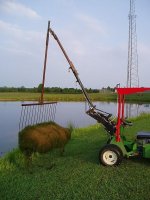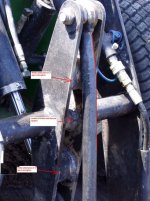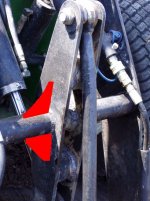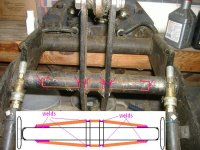J_J
Super Star Member
- Joined
- Sep 6, 2003
- Messages
- 18,973
- Location
- JACKSONVILLE, FL
- Tractor
- Power-Trac 1445, KUBOTA B-9200HST
Perhaps we should start a list of any one that has welded or replaced the roll over assembly.
Some of these problems are caused by over working the machine. For instance, when the PT pucker occurs, do you realize that you are lifting about 1000 lbs behind the front wheels. The 425 weighs 1375 lbs, but several hundred are forward of the front wheel. When you are trying to lift that large bolder or large bucket with what ever, you could be putting stress on that roll-over assembly. You do that enough times, and you will get stress cracks, which will lead to failure of the roll-over assembly. Whether you realize it or not, there is this thing called reverse pressure. That is when the material you are trying to work with, overloads the hydraulics by putting more pressure on the circuit than you are generating. I have watched the lift and tilt cylinders work against each other, and I try and avoid this situation. Some thing will burst or bend. I have some flat spots in the round tubes that connect the two lift arms together. I believe this was caused by undue force, which means going beyond acceptable limits. My roll-over assembly did not crack, but the pin and tube bonded together so hard, that it would not move. We may think that our machines are invincible, but they are not. Tuff enough, yes.
Some of these problems are caused by over working the machine. For instance, when the PT pucker occurs, do you realize that you are lifting about 1000 lbs behind the front wheels. The 425 weighs 1375 lbs, but several hundred are forward of the front wheel. When you are trying to lift that large bolder or large bucket with what ever, you could be putting stress on that roll-over assembly. You do that enough times, and you will get stress cracks, which will lead to failure of the roll-over assembly. Whether you realize it or not, there is this thing called reverse pressure. That is when the material you are trying to work with, overloads the hydraulics by putting more pressure on the circuit than you are generating. I have watched the lift and tilt cylinders work against each other, and I try and avoid this situation. Some thing will burst or bend. I have some flat spots in the round tubes that connect the two lift arms together. I believe this was caused by undue force, which means going beyond acceptable limits. My roll-over assembly did not crack, but the pin and tube bonded together so hard, that it would not move. We may think that our machines are invincible, but they are not. Tuff enough, yes.





